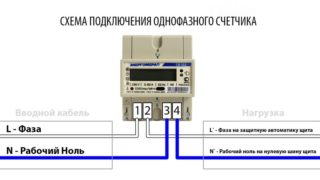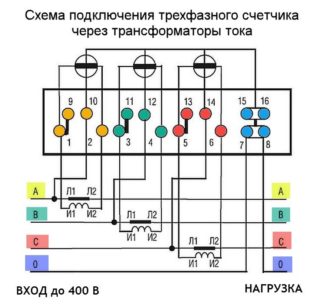For household electrical networks for 220 and 380 V, induction or electronic metering devices are used. In the process of replacing obsolete devices or installing new ones, the connection diagram of the electric meter is selected depending on the number of phases and the power of the load. The device is installed with its obligatory registration and sealing.
- Types and features of counters
- By the principle of action
- By the number of tariffs
- By fastening method
- The legality of self-connection
- Rules and requirements for meter installation
- The procedure for connecting an old meter
- Choosing a scheme
- Stages of work
- Features of the connection diagram for a single-phase meter in the dashboard
- Features of connecting three-phase meters
- Direct connection specifics
- Indirect connection
- Installation materials
- Connection stages
- Characteristics of some models of electricity meters
Types and features of counters
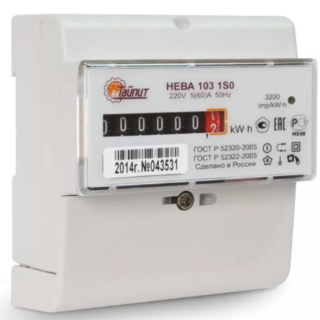
An electric meter is a special device that allows you to keep track of the consumption of DC or AC energy. It is designed for installation in an apartment or house. There are several types of devices.
By the principle of action
Manufacturers release the following modifications:
- Electromechanical. An induction electric meter operates on the principle of the formation of a magnetic field by two coils - current and voltage. The field rotates the disk, and it activates the counting mechanism. When the parameters of current and voltage are increased, the disk spins faster. The warranty period of the products is 15 years.
- Electronic. The device is compact, counts according to several tariffs. The electronic device displays the readings on the display and stores them in memory. It can be connected to the smart home system.
The accuracy of induction models is 2.5. Electronic ones often fail.
By the number of tariffs
There are models:
- one-rate - keep records according to one system;
- multi-tariff - calculate the energy consumption according to the day and night tariffs.
Devices with several tariffs are optimal for rooms with a large number of household appliances.
By fastening method
The devices are installed on fixing bolts or DIN rail.
It is necessary to select the power of the apparatus according to the power of all equipment.
The legality of self-connection
Connecting an apartment electricity meter without sealing it is classified by the legislation of the Russian Federation as unaccounted consumption. It means the absence of an agreement with the provider, independent installation or shutdown of the device, failure to provide information on the amount of consumed energy resources. The violator is subject to sanctions in the form of a fine in the amount of 4 thousand rubles. The basis is Art. 7.19 of the Administrative Code.
According to paragraph 81 (8-9) and paragraph 81 (14) of Government Decree No. 354, citizens apply to the energy sales office to sign an agreement and install a control seal. Only after installing the seals is it allowed to connect the meter.
Sealing is a free procedure.
Rules and requirements for meter installation
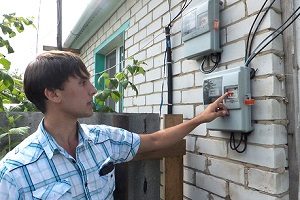
Before connecting the counting device, you need to study the standards. They contain the following connection conditions:
- the transfer of the device on the basis of Government Decree No. 354 is carried out at the expense of the user, if this does not contradict the requirements of the PUE;
- the installation of the device is carried out in rigid cabinets, switchgear, on panels, walls, in niches;
- settlement nodes are placed on the border of the operational responsibility of the consumer and the provider - the input of the apartment, the ASU, the main switchboard;
- the screen of the accounting tool should be easily viewed by representatives of the supplier company;
- for a network with a voltage of up to 380 V, the rule applies - the distance of the electric meter to the switching devices is not more than 10 m;
- installation of the meter on the street is carried out in a sealed case at a temperature of +5 degrees;
- the counter is placed at a height of 0.8 to 1.7 m. The optimum height is 1.4 m.
The term of the manufacturer's seal on a three-phase electrical apparatus should not exceed 2 years, on a single-phase one - 1 year.
The procedure for connecting an old meter
Outdated counting devices include single-phase models that count electricity at a general rate. They are installed in an apartment or a private house.
Choosing a scheme
The sequence for connecting a single-phase electricity meter is indicated in the passport, instructions or form from the manufacturer. You can find the schematic in the instruction manual or on the back of the terminal cover.
Stages of work
The terminals are connected to the wires as follows:
- terminal No. 1 - white / brown / black phase input cable;
- terminal No. 2 - white / black / brown input phase wire from which the apartment is powered;
- terminal No. 3 - neutral blue / blue-blue conductor of the input cable;
- terminal no. 4 - blue / blue-blue zero load output cable.
Additional terminals are used to connect to the service equipment.
Features of the connection diagram for a single-phase meter in the dashboard
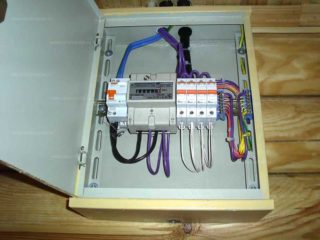
For a home electrical network, the connection of the electricity meter is carried out in conjunction with protection devices. All nodes are in SCHUR. To connect a single-phase electricity meter you will need:
- Install a single-pole switch and insert the phase input cable into it.
- From the single-pole circuit breaker, bring the phase to terminal No. 1 of the meter.
- Bring the working zero to terminal No. 3 and the protective zero to the neutral bus.
This scheme is recommended by the PUE and is suitable if an old accounting device is installed in the house.
Features of connecting three-phase meters
The three-phase meter circuit is implemented directly or indirectly. The first option is suitable for low-power consumers, the second for equipment in a three-phase network.
Direct connection specifics
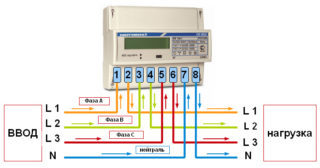
Connect the device in a direct way as follows:
- Stripping the cable from insulation and connecting it to a three-phase circuit breaker.
- Connection of three phase cables to terminals No. 2, 4 and 6 of the meter.
- Output of phase wires to terminals No. 1, 3 and 5.
- Input of the input (terminal No. 7) and output (terminal No. 8) neutral wires.
- Installation of 3-pole circuit breakers.
For a single connection of single-phase devices from the outgoing phase, wires from the neutral to ground are used. Several groups of single-phase consumers are supplied evenly through switches of different phases.
Indirect connection
An indirect connection scheme for a three-phase electric meter is realized by fixing the transformers to the back of the cabinet. The primary windings are connected after the input breaker and protection fuses to break the phase cables. The connection is done like this:
- Supply of one end of a cable with a cross-section of 1.5 mm2 to the section from the power wire of the A-phase to the transformer.
- Lead out the second end of the cable to terminal No. 2 of the meter.
- Similar connection of wires of phase B and C, their output to terminals No. 5 and No. 8.
- Laying wires with a cross section of 1.5 mm2 in the direction from the terminals of the secondary winding to terminals No. 2 and 3 of the electricity meter.
- A similar connection of the windings of devices B and C to terminals No. 4, 6 and No. 7, 9.
- Connection of terminal No. 10 to a common neutral bus.
If the phasing is not observed, the device will give incorrect readings.
Installation materials
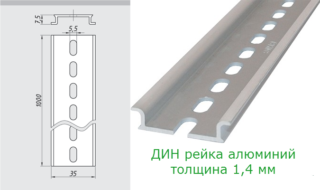
The electrical meter is connected after choosing a scheme and purchasing materials. To correctly and efficiently connect an apartment meter, you will need:
- automatic switches taking into account the maximum current rating;
- insulating devices;
- tools with insulated handles;
- fasteners - screws and nuts;
- wires;
- din rail.
Further work is carried out according to a strict algorithm.
Connection stages
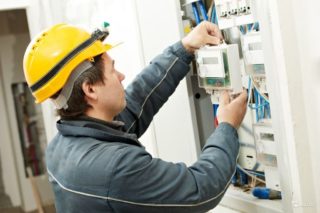
Initially, you need to calculate how many phases are in the home electrical network. The number of circuit breakers is selected for them. In the future, the device will connect like this:
- Fixing the device in the dashboard with special clamps.
- Installation of the rail on the insulators in the box with screws.
- Mounting of circuit breakers on a rail and fixing with a latch.
- Fixing the ground and protection busbars to the rail or insulators in the shield so that there is a gap between them.
- Connecting the load to the switches.
- Connecting the machine to the counter.
- Load connection.
- Installation of connecting jumpers.
- Connecting the meter to consumers.
- Fastening the panel box to the wall.
- Inspection of wires for correct connection.
Only after checking the cables can you turn on the power to a residential building or garage. At the last stage, the user contacts the power supply company to test the equipment and install seals.
Characteristics of some models of electricity meters
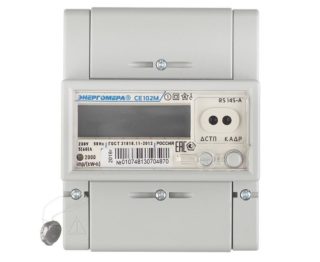
When choosing a meter yourself, you need to take into account how electricity will be consumed. Manufacturers produce models that can accurately track energy costs:
- SRZU-I 70D. An impulse device that simultaneously transmits, collects and analyzes information. A measuring transformer is used to power the sensor. The receiving node through the electrical circuit receives the LED signal about the energy consumption for a certain period of time. The data is displayed on the screen;
- Mercury 234 ARTM - RO PB. The three-phase multi-tariff model is designed for a network with a current of 5-10 A. Installed on the street, because works flawlessly at temperatures from -40 to +70 degrees. Accuracy class of the device - 0.5;
- PSCH-4TM 0.5 MK. A multi-tariff single-phase device operates at a current strength of 5-10 A. The accuracy of the readings is 0.5. Designed for operation in the temperature range from -40 to +60 degrees;
- CE 102M S7145-JV. Designed for 4 tariffs, has the 1st class of accuracy. The universal multi-tariff device is suitable for a 220-230V network with a current strength of 5 to 60 A.
The presented models are intended for apartments, residential buildings and cottages, because allow you to plan and calculate energy costs.
The algorithm for self-connecting the meter is based on its type and the number of phases in the network. Before starting work, it is necessary to agree on the installation, conclude an agreement with the energy sales company. The device must be sealed.

